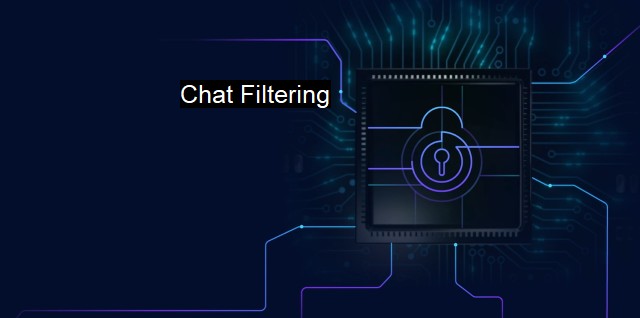What is Chat Filtering?
The Importance of Chat Filtering in Today's Cybersecurity Landscape: Countering Threats and Protecting Users from Malicious Content
Chat filtering refers to the multifaceted data filtering mechanism adept at identifying and barring certain words, phrases, or sentences that are abusive, explicit, or a potential security threat. Specifically relevant in the cybersecurity domain, chat filtering functions as protective networking gear to shield users, especially minors, from harmful online material over chat interfaces. Often integrated within anti-virus software, this method becomes an excellent machination to combat cyber risks that might present themselves while interacting on internet-powered interfaces.Cybersecurity and antivirus both work to protect digital user ecosystems from being infringed or exploited. With cybercrimes surging high, the relevance of cyber defenses including antivirus programs and chat filters amplify manifolds. Structuring as a string defense while exchanging messages, chat filtering robustly screens conversations to keep offensive, abusive, or invasive content at bay.
Chat filters are algorithm-based intelligent protocols that scan lines of chat text in real time, flagging or blocking certain types of content based on predefined categories. These predefined categories can stretch over offensive language, personal information, solicitation, hate speech, bullying, or any form of inappropriate communication that might threaten digital integrity or personal safety. Typical examples span restricting profanity, insults, illegal content, explicit content, or phishing links.
Integrated into chat platforms, online games, discussion forums, and social media sites, chat filtering enables a safer virtual environment. Filtering effectiveness depends on the complexity of the integrated filter system. Simple ones will red mark profanity, while advanced systems can recognize, interpret, and block subtle online bullying, hate speech, or manipulative statements.
One crucial layer chat filtering yields to cybersecurity is its capability to detect unsolicited malicious URLs sent via chat bots, barring such links that might lead to potential phishing. Phishing URLs, in disguise of reliable links, aim to unlawfully data-mine sensitive information for devious exploits. Highly sophisticated chat filters, equipped in modern antivirus packages, quickly recognize these malicious links and restrict their transactions, fortifying digital security multifold.
Most antivirus software these days comes equipped with chat filtering technologies. These antiviruses that provide real-time analysis and scanning of textual content assist in creating reliable online ecosystems. By regularly updating virus definitions, enhancing firewall advantages, strengthening computer systems against Trojan horses, spyware, and other malware, an antivirus sustains several layers of computer security. With chat filtering woven into this mix, antivirus software extends computer security to user privacy in online communications.
Like any other cybersecurity application, chat filters also bear drawbacks. Their overstrict policies might occasionally block harmless conversations while racial slurs, vulgar language encased in coded language could sneak by, enfeebling user security. Ensuring parental control modes or employing high-sensitivity filters can address this issue. Similarly, criminals may employ other workarounds or invent new tactics to dodge filters, hence constant update is necessary to maintain the efficacy.
Despite these slight fallibility, chat filters are an integral facet of the wholesome cybersecurity strategy propagated by global regex pattern industries currently battling surging cybercrimes and extensive online threats. Conclusively, integrating effective chat filtering practices translates to tangible improvements in user safety online, broader social conscience about internet usage, and a step forward in instating human dignity – even in the virtual world.

Chat Filtering FAQs
What is chat filtering?
Chat filtering is the process of scanning and analyzing digital communication in real-time, such as chat messages, to identify and block potentially harmful content. It is an essential part of cybersecurity and antivirus software, designed to protect users from cyber threats and inappropriate messages.How does chat filtering work?
Chat filtering works by using a combination of AI (Artificial Intelligence) and ML (Machine Learning) algorithms to scan the content of messages while they are being transmitted. The system then compares the content of the message against a database of keywords and phrases that are considered harmful or inappropriate. If the message contains such content, it is either flagged or blocked from being delivered.What are the benefits of chat filtering?
Chat filtering provides several benefits, including: 1. Protecting users from cyber threats and malware that can be spread through chat messages. 2. Filtering out inappropriate messages that may contain offensive language or bullying. 3. Helping businesses to comply with legal regulations related to cyber safety and online privacy. 4. Ensuring that chat conversations remain productive, on-topic, and focused on the intended purpose.Are there any limitations to chat filtering?
While chat filtering is an effective tool for protecting users from cyber threats and inappropriate messages, there are some limitations to its effectiveness. For example: 1. Chat filtering may not be able to detect new, previously unknown threats or types of inappropriate content. 2. Chat filtering may generate false positives, blocking legitimate messages that contain no harmful or inappropriate content. 3. The effectiveness of chat filtering can be undermined if users find ways to circumvent the system, such as by using code words or misspelled words.| | A | | | B | | | C | | | D | | | E | | | F | | | G | | | H | | | I | | | J | | | K | | | L | | | M | |
| | N | | | O | | | P | | | Q | | | R | | | S | | | T | | | U | | | V | | | W | | | X | | | Y | | | Z | |
| | 1 | | | 2 | | | 3 | | | 4 | | | 7 | | | 8 | | |||||||